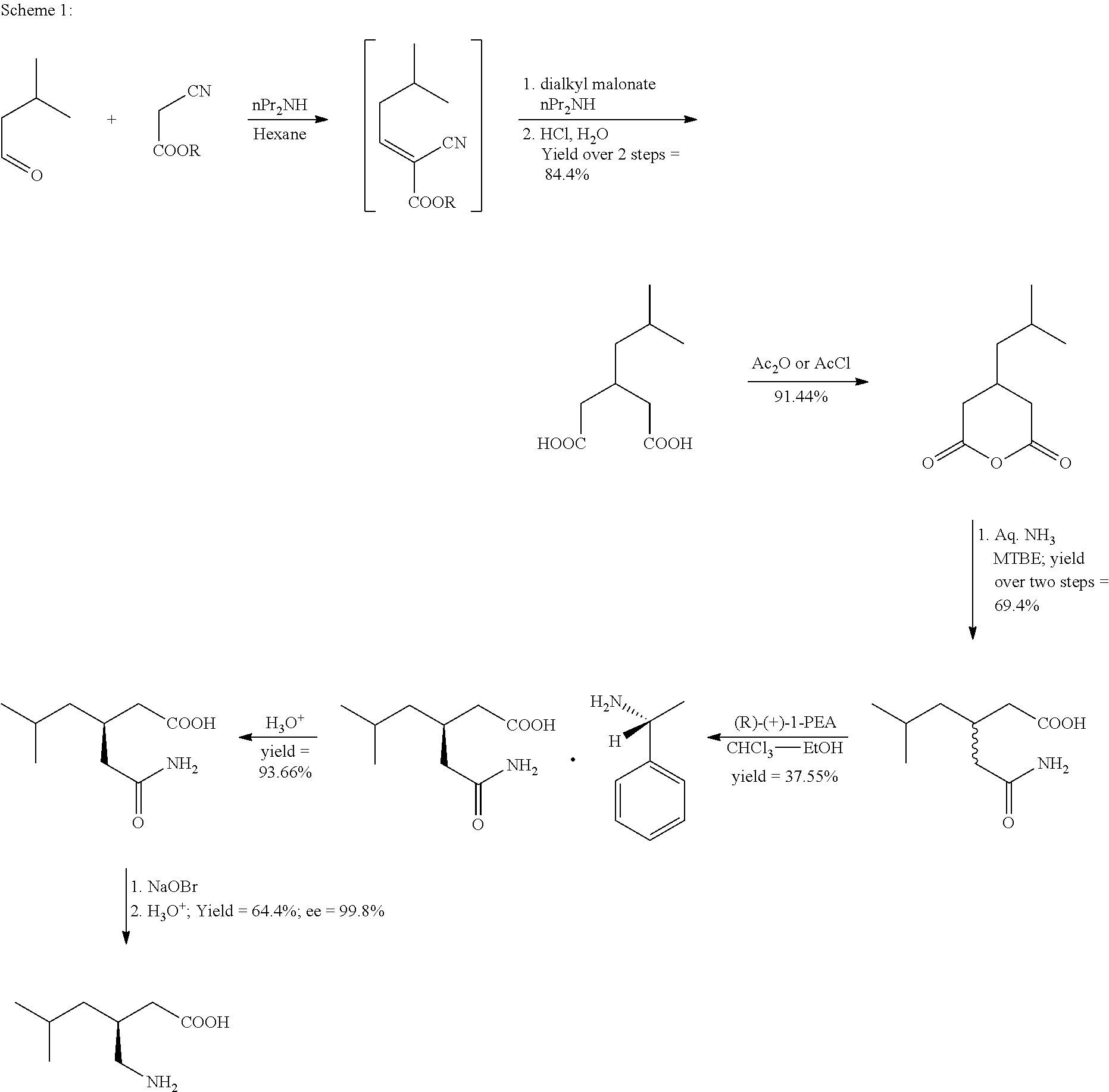Process for the preparation of pregabalin
- Summary
- Abstract
- Description
- Claims
- Application Information
AI Technical Summary
Benefits of technology
Problems solved by technology
Method used
Image
Examples
example 1.1
Preparation of 2-cyano-5-methyl-hex-2-enoic acid methyl ester
[0072]In a 3 liter four necked RBF, equipped with mechanical stirrer, Dean-Stark condenser methyl cyano acetate (300.0 g), isovaleraldehyde (273 g; 1.05 equiv.) and cyclohexane (210 ml; 0.7 V) were added at room temperature under stirring followed by addition of piperidine (2.7 g; 0.01 equiv.) in cyclohexane (90 ml; 0.3 V through addition funnel. Exothermic reaction was observed (temperature rises from 22° C. to 58° C.). The reaction mixture was refluxed and water was collected azeotropically from Dean-Stark (55 ml) during 2 hrs. After completion of reaction, arrange the distillation set up and distilled out 260 ml of cyclohexane from RM by applying line vacuum at 50° C. The reaction mixture was allowed to cool at 30° C. to get the desired compound 515 gm (>100% of theoretical yield) with purity of 95.90% by GC and this material was used as such for subsequent step. 1H-NMR (CDCl3, 400 MHz): 0.98 (d, 6H), 1.92 (m, 1H), 2.45...
example 1.2
Preparation of 2-cyano-5-methyl-hex-2-enoic acid methyl ester
[0073]In a 3 liter four necked RBF, equipped with mechanical stirrer, Dean-Stark condenser methyl cyano acetate (300.0 g), isovaleraldehyde (273 g; 1.05 equiv.) and cyclohexane (210 ml; 0.7 V) were added at room temperature under stirring followed by addition of piperidine (2.7 g; 0.01 equiv.) in cyclohexane (90 ml; 0.3 V through addition funnel. Exothermic reaction was observed (temperature rises from 22° C. to 58° C.). The reaction mixture was refluxed and water was collected azeotropically from Dean-Stark (55 ml) during 3.5 hrs. d 510 gm (100.8% of theoretical yield) with purity of 93.76% by GC and this material was purified by distillation under vacuum to give desired compound 414.78 g (81.33%; purity by GC 97.2%) and another enriched fraction of 53.7 g (10.53%; GC purity 90.03%) which can be recycled for subsequent batch.
example 1.3
Preparation of 2-cyano-5-methyl-hex-2-enoic acid methyl ester
[0074]In a 100 ml two necked RBF, equipped with mechanical stirrer and addition funnel methyl cyano acetate (5.0 g), isovaleraldehyde (4.35 g; 1.0 equiv.) and cyclohexane (3.5 ml; 0.7 V) were added at room temperature under stirring followed by addition of piperidine (0.043 g; 0.01 equiv.) in cyclohexane (1.5 ml; 0.3 V through addition funnel. Exothermic reaction was observed (temperature rises from 22° C. to 58° C.). The reaction mixture was stirred at ambient temperature (25-30° C. for 3 h. After completion of reaction, the reaction mixture was washed with water. It was optionally dried over anhydrous Na2SO4. Solvent was removed by distillation and the residue was dried under vacuum to get the desired compound 510 gm (100.8% of theoretical yield) with purity of 93.76% by GC and this material was purified by distillation under vacuum to give 8.5 g (>100%; purity by GC 91.5).
PUM
| Property | Measurement | Unit |
|---|---|---|
| Temperature | aaaaa | aaaaa |
| Temperature | aaaaa | aaaaa |
| Temperature | aaaaa | aaaaa |
Abstract
Description
Claims
Application Information
 Login to View More
Login to View More - R&D
- Intellectual Property
- Life Sciences
- Materials
- Tech Scout
- Unparalleled Data Quality
- Higher Quality Content
- 60% Fewer Hallucinations
Browse by: Latest US Patents, China's latest patents, Technical Efficacy Thesaurus, Application Domain, Technology Topic, Popular Technical Reports.
© 2025 PatSnap. All rights reserved.Legal|Privacy policy|Modern Slavery Act Transparency Statement|Sitemap|About US| Contact US: help@patsnap.com



